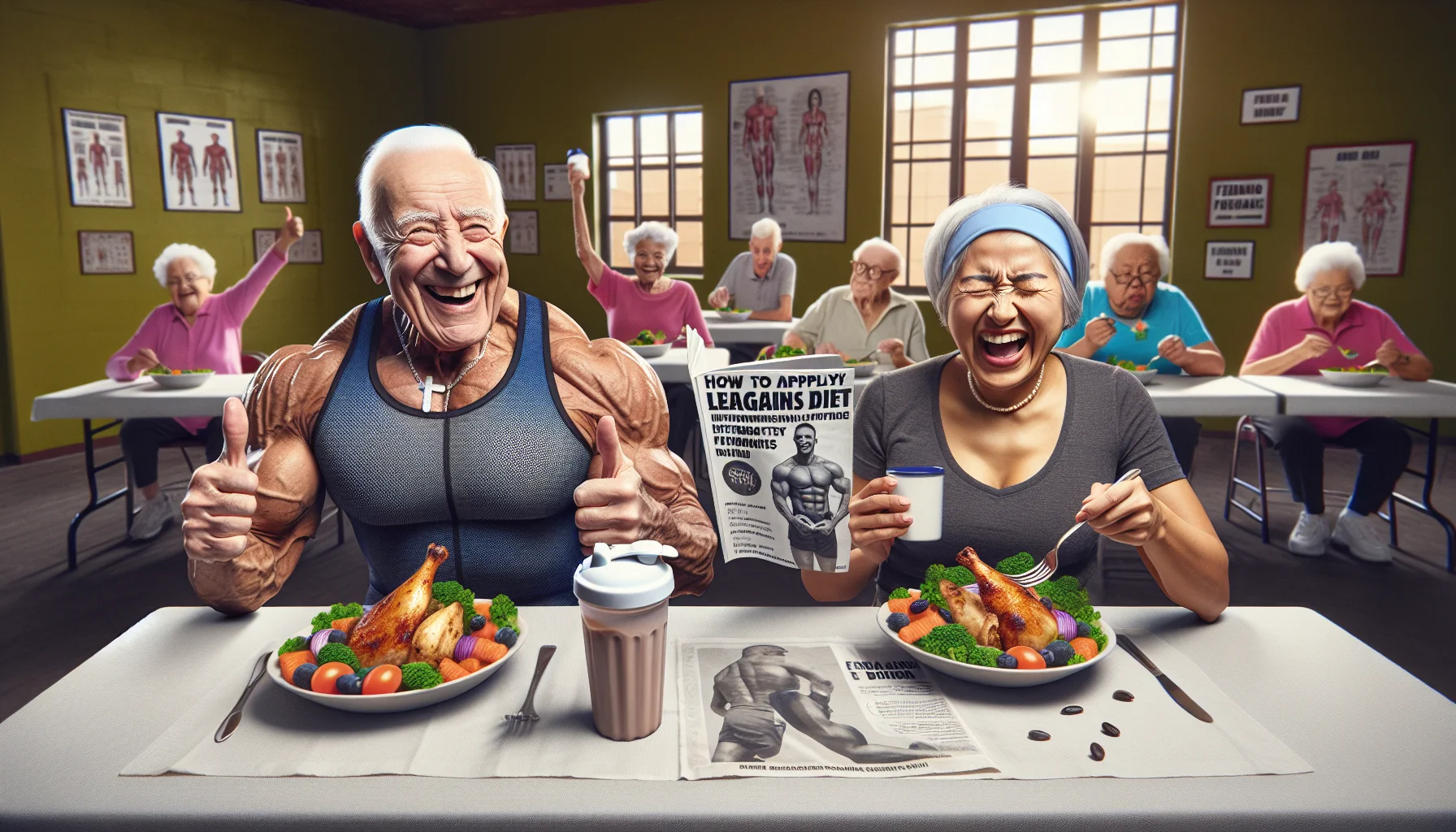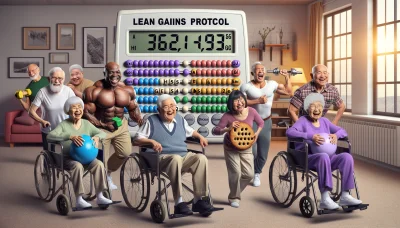Leangains diet Quiz
Test Your Knowledge
Question of
Understanding the Leangains Diet
What is Intermittent Fasting?
Intermittent fasting (IF) is a dietary strategy that cycles between periods of fasting and eating. It's not about which foods to eat, but rather when you should eat them. This approach has gained popularity for its simplicity and the flexibility it offers compared to traditional diet plans.
There are several variations of IF, each with its own rules about fasting and eating. The common thread is the alternation of fasting periods with eating windows, which can lead to various health benefits when practiced consistently.
The 16/8 Method: Exploring the Core of Leangains
The Leangains method revolves around the 16/8 method, which involves fasting for a continuous 16 hours followed by an 8-hour feeding window. This pattern maximizes the body's fat-burning potential during the fasting state while allowing for nutrient intake during the eating period.
Adherence to this eating schedule can be challenging at first, but it becomes more manageable over time. The key is to align the fasting period with your sleep schedule to minimize hunger and maintain energy levels throughout the day.
Health Benefits of Time-Restricted Eating
Time-restricted eating, like the Leangains approach, has been linked to numerous health benefits. These include improved metabolic health, weight loss, and reduced inflammation. By limiting your eating window, you give your body a chance to process nutrients efficiently and burn stored fat.
Additionally, intermittent fasting may enhance brain function and longevity by promoting cellular repair processes and reducing oxidative stress. It's a lifestyle change that could have far-reaching positive effects on overall health.
The Role of Macronutrients in Leangains
In the Leangains diet, macronutrients play a pivotal role in achieving fitness goals. Each macronutrient proteins, carbohydrates, and fats serves specific functions in muscle growth, energy provision, and bodily functions. It's essential to understand their balance for optimal results.
Proper macronutrient distribution can significantly impact your performance during workouts and recovery. The Leangains protocol emphasizes higher protein intake due to its muscle-sparing effects and ability to promote satiety.
Balancing Proteins, Carbs, and Fats
Balancing macronutrients in the Leangains diet is not one-size-fits-all; it requires customization based on individual goals and activity levels. A higher proportion of protein supports muscle repair while carbs fuel workouts and fats provide essential nutrients.
- Consume Adequate Protein: Aim for a high protein intake to support muscle growth and maintenance.
- Adjust Carbohydrates: On workout days, increase carbohydrate intake for energy; reduce on rest days to aid fat loss.
- Moderate Fat Intake: Healthy fats are vital for hormonal balance but should be consumed in moderation due to their high caloric density.
- Vary According to Activity: Tailor your macronutrient ratios according to your training intensity and daily activity levels.
- Maintain Nutritional Balance: Even though you're focusing on macros, don't neglect micronutrientsvitamins and minerals are crucial for overall health.
Tailoring Your Macros to Training Days
On training days within the Leangains program, it's crucial to increase carbohydrate intake for energy replenishment while slightly lowering fat consumption. This shift helps facilitate recovery by replenishing glycogen stores used during exercise.
The strategic manipulation of macronutrients around workout sessions enhances performance while contributing to lean mass gain or retention. Adjusting your intake according to your training schedule aligns with your bodys nutritional demands, maximizing the benefits of both dieting and exercise efforts.
Getting Started with Leangains
Creating Your Leangains Meal Plan
Kickstart your Leangains journey with a well-crafted meal plan tailored to fuel your body and complement your fasting schedule. Begin by calculating your daily caloric needs based on your goals, whether it's fat loss, muscle gain, or maintenance. Remember, consistency is key in achieving the results you're after!
When designing your meal plan, consider macronutrient ratios that align with the Leangains philosophy. A higher protein intake supports muscle repair and growth, especially critical on this regimen. Carbs and fats are also essential, but their proportions may vary based on individual energy needs and workout intensity.
Structuring Your Eating Window
The cornerstone of Leangains is the 16/8 intermittent fasting approach16 hours of fasting followed by an 8-hour eating window. Optimize this window by timing your meals around your workouts. This strategy helps with nutrient uptake when your body is primed for it. Most importantly, stick to the schedule to maintain a rhythm that your body can adapt to.
Be strategic within your eating window by planning the number and timing of meals to suit your lifestyle. Whether you prefer three square meals or several smaller ones, ensure each is balanced and supports your nutritional needs. The goal is to stay satiated and energized without feeling deprived.
Choosing Foods for Optimal Nutrition
Selecting high-quality foods is crucial for maximizing the benefits of Leangains. Prioritize lean proteins like chicken breast, fish, and tofu; these are foundational for muscle synthesis. Add a variety of vegetables for fiber and micronutrientsthese will also help fill you up without excess calories.
Complex carbohydrates such as sweet potatoes, brown rice, and whole grains should be included to sustain energy levels throughout the day. Healthy fats from avocados, nuts, and olive oil are equally important for hormonal health and satiety. Remember to hydrate wellwater intake is a non-negotiable aspect of any nutrition plan.
- Don't skip veggies: They provide essential vitamins and keep you full.
- Moderate fats: Choose quality sources but don't overindulge.
- Beware of hidden sugars: They can creep into sauces and dressings.
- Prioritize protein: It's vital for muscle repair, especially on workout days.
- Stay hydrated: Sometimes thirst is mistaken for hunger.
- Avoid processed foods: They're often calorie-dense with little nutritional value.
- Mix it up: Variety prevents boredom and ensures a range of nutrients.
- Listen to your body: Adjust portions if you feel consistently hungry or too full.
Establishing a Workout Routine
Your workout routine is pivotal in leveraging the Leangains method effectively. Aim to create a balanced program that includes compound movements such as squats, deadlifts, bench presses, and rowsthese exercises work multiple muscle groups simultaneously for efficient strength gains. Be sure to allow adequate recovery time between sessions; muscles grow outside the gym!
An effective routine should evolve over time; progressive overload is essential for continuous improvement. Gradually increase weights or reps as you get stronger to challenge your muscles further. Tracking workouts can be incredibly motivating as you see tangible progress in your strength journey!
Resistance Training in the Leangains Protocol
Incorporating resistance training into your regimen at least three times per week aligns perfectly with Leangains principles. Focus on heavy lifting with high intensitythis stimulates muscle growth and increases metabolic rate post-workout (the afterburn effect). Shorter rest periods between sets can keep intensity high while still allowing enough recovery time for performance.
The unique aspect of resistance training within Leangains is its synergy with fasting. Training in a fasted state may enhance fat oxidation while preserving muscle massa double win! Just ensure proper pre- and post-workout nutrition during your eating window to replenish energy stores and aid recovery.
Incorporating Cardio: Should You Do It?
The role of cardio within Leangains can be quite nuancedit's not the focal point but can complement the protocol when used judiciously. Low-intensity steady-state (LISS) cardio like walking or cycling can be beneficial on rest days as it aids recovery without taxing glycogen stores excessively.
If opting for high-intensity interval training (HIIT), limit sessions to avoid interference with recovery from resistance training sessions. HIIT can be effective in short bursts to boost metabolism without significantly impacting muscle-building efforts when done correctly within the framework of Leangains.
Overcoming Common Challenges
Dealing with Hunger and Cravings
Hunger and cravings can seem like formidable foes in our daily lives, but fear not! With the right strategies, they can be tamed. Recognizing that these sensations are often temporary can empower you to push through the discomfort. Remember, understanding your body's signals is key to mastering your responses.
Distraction is a powerful tool. Engaging in activities that keep your mind occupied can considerably lessen the intensity of hunger pangs. Whether it's a brisk walk, a gripping book, or a new hobby, redirecting your focus is a practical way to manage those cravings.
Strategies to Manage Appetite During Fasting
Fasting doesn't have to be a grueling ordeal. Staying hydrated is a simple yet effective method to curb appetite. Often, our bodies confuse thirst for hunger, so reaching for water first is always a smart move. Incorporating high-fiber foods during your eating windows also helps provide a lasting sense of fullness.
Intermittent fasting is gaining momentum as a lifestyle choice for many. It's about timing and balance rather than deprivation. Planning your fasting schedule to align with your most hectic parts of the day can keep hunger at bay since you'll be too busy to think about food.
Mindful Eating to Combat Cravings
- Eat Slowly: Take time to chew your food thoroughly and enjoy each bite. This practice enhances digestion and signals fullness more effectively.
- Avoid Distractions: Eating while watching TV or scrolling through social media can lead to overeating. Focus on your meal instead.
- Understand Your Triggers: Identify emotional cues that lead to cravings and address them without resorting to food as comfort.
- Balanced Diet: Ensure your meals are nutritionally complete to prevent nutrient deficiencies that might trigger cravings.
- Healthy Substitutions: Find healthier alternatives that satisfy your cravings without derailing your dietary goals.
Staying Motivated and Consistent
Motivation is the fuel for the journey towards any goal, yet consistency is the vehicle that gets you there. Setting realistic expectations and celebrating small victories will bolster your drive and encourage steadfastness in your endeavors. Remember, every step forward is progress!
Sometimes motivation wanes, but discipline ensures you stay the course. Establishing routines creates automaticity in behavior which helps maintain momentum even on days when motivation dips. Discipline transforms good intentions into results through consistent action.
Tracking Progress Effectively
Data doesn't lie! Keeping track of your progress with tools such as apps or journals provides tangible evidence of your achievements. This feedback can be incredibly motivating and help refine strategies as you forge ahead on your health journey. Visual representations like graphs or charts make it even more compelling!
Celebrate all wins, no matter how small they may seem! Tracking progress isnt just about numbers; its also about acknowledging effort and commitment. Reflecting on how far you've come reinforces self-belief and fuels the desire to continue pushing boundaries.
Building a Supportive Community
You're not alone in this! A supportive community provides an invaluable network of encouragement and advice. Sharing experiences with others who understand the struggle can offer fresh perspectives and morale boosts just when you need them most.
Leveraging social media groups or local clubs focused on similar goals can connect you with like-minded individuals. These connections often lead to friendships that transcend shared challenges, reinforcing the human need for social bonds while pursuing personal growth.
Fine-Tuning Your Diet for Results
Adjusting Calories for Weight Loss or Gain
Achieving your fitness goals often hinges on the critical balance of calories consumed versus calories expended. To lose weight, you must create a caloric deficit, which means consuming fewer calories than your body burns. Conversely, to gain weight in the form of muscle, you'll need to consume more calories than you expend, ensuring these are nutritious and support muscle growth.
Fine-tuning your diet begins with understanding your basal metabolic rate (BMR) and total daily energy expenditure (TDEE). These metrics provide a starting point for determining how many calories you should be consuming. Remember that as you lose or gain weight, or increase physical activity, these numbers will change and so should your calorie intake.
Calculating Your Caloric Needs
Calculating your caloric needs is vital to tailor your diet for results. A variety of factors including age, gender, weight, height, and physical activity level influence your caloric requirements. There are several online calculators and formulas such as the Harris-Benedict equation that can help estimate your BMR and TDEE for better dietary planning.
Once you have an estimate of your caloric needs, track what you eat using a food diary or app. Monitoring intake helps ensure accuracy in meeting your caloric goals. It's also important to consider the quality of calories consumed; focus on whole foods rich in nutrients for optimal health and performance.
When to Adjust Your Intake for Plateaus
Hitting a plateau can be frustrating when striving towards weight loss or gain. When progress stalls, it's time to reassess and adjust your calorie intake. For weight loss plateaus, consider reducing your intake by an additional 100-200 calories per day. For gaining muscle without progress, incrementally increase your calories with a focus on protein.
Be mindful not to make drastic changes too quickly; small adjustments are less shocking to the system and more sustainable long term. Listen to your body's cues and make sure any dietary changes still align with nutritional adequacy and overall well-being.
Optimizing Meal Timing Around Workouts
The timing of meals can significantly impact workout performance and recovery. Consuming the right balance of nutrients before and after exercise optimizes energy levels during workouts and aids in muscle repair post-exercise. Aim for a mix of carbohydrates and protein before training to fuel activity and initiate recovery afterwards with protein to aid muscle repair.
- Pre-Workout: Consume a meal high in complex carbohydrates with moderate protein 2-3 hours before exercise for sustained energy.
- Post-Workout: After exercising, aim to consume protein within 45 minutes to kickstart recovery processes.
- Hydration: Maintain hydration before, during, and after workouts to support optimal physiological functions.
- Balanced Snacks: If there's no time for a full meal pre-workout, choose a simple carb snack like fruit 30 minutes prior.
- Avoid Heavy Fats: Minimize high-fat foods before exercising as they can slow digestion and affect performance.
Pre- and Post-Workout Nutrition
Pre-workout nutrition is all about setting the stage for optimal performance. A meal rich in complex carbs provides sustained energy release while including some protein supports muscle endurance. Post-workout nutrition pivots towards recovery; prioritize protein synthesis by consuming a protein-rich snack or shake shortly after finishing exercise.
Fasted Training: Pros and Cons
Fasted training has become popular among those looking to optimize fat oxidation rates during exercise. Training on an empty stomach might promote increased fat utilization; however, it may also compromise workout intensity due to low energy availability. Consider individual tolerance levels and goals before incorporating fasted training into your routine.
Advanced Strategies in Leangains
Cycling Carbohydrates and Fats
Carbohydrate and fat cycling are cornerstones of the Leangains protocol, designed to optimize both fat loss and muscle gain. By alternating macronutrient intake, the body's metabolism is kept guessing, which can lead to improved body composition over time. This method leverages the anabolic properties of insulin on high-carb days, while promoting fat oxidation on low-carb days.
Strategically manipulating your diet this way can also have psychological benefits. It allows for greater flexibility and variety, making it easier to adhere to your nutrition plan in the long run. Consistency is key, so implementing a carb and fat cycling routine that aligns with your training schedule can enhance overall performance.
High-Carb Days Explained
On high-carb days, you'll fuel up with quality carbohydrates to replenish glycogen stores and support workout performance. These are typically aligned with your most intense training sessions, when your body's demand for energy is highest. By doing so, you maximize muscle growth and recovery thanks to the anabolic effects of insulin.
When planning high-carb days, focus on complex carbs like sweet potatoes, oats, and brown rice. These not only provide sustained energy but also contain fiber which aids in digestion. Remember that timing matters consuming the majority of your carbs post-workout can enhance nutrient uptake and muscle repair.
The Role of Low-Carb Days in Fat Loss
Low-carb days complement high-carb days by focusing on fat as the primary energy source. This encourages the body to tap into stored fat for fuel, aiding in weight loss without sacrificing muscle mass. These days should coincide with lighter training sessions or rest days to match your reduced energy requirements.
During low-carb periods, increase your intake of healthy fats from sources like avocados, nuts, and fish. This shift not only supports fat loss but also helps maintain hormone levels and satiety. It's crucial not to drop carbs too low or for too long as this can hinder performance and recovery.
- Maintain Balance: Don't eliminate carbs entirely; they're essential for brain function and energy.
- Quality Over Quantity: Choose nutrient-dense carbs and fats to maximize health benefits.
- Listen to Your Body: Adjust carb intake based on activity level and personal response.
- Avoid Extremes: Extreme carb cutting or overindulgence can both negatively impact progress.
- Stay Hydrated: Water intake is crucial during any dietary change, especially when manipulating carbs.
- Sleep Matters: Adequate rest supports metabolic health and effective nutrient utilization.
Intermittent Fasting and Autophagy
The Leangains method incorporates intermittent fasting (IF) as a tool for weight management and health improvement. IF involves restricting food intake to a specific window of time each day, which can simplify dieting by reducing meal frequency. This practice has been linked not only to fat loss but also to improvements in insulin sensitivity and cardiovascular health.
Fasting isn't just about calorie control; it's about giving your digestive system a break while triggering beneficial cellular processes. Intermittent fasting aligns well with human circadian rhythms, potentially leading to better sleep patterns and increased growth hormone release during fasting periods.
Understanding Cellular Autophagy
Autophagy is a cellular clean-up process that gets activated during fasting states. It allows cells to remove damaged components, leading to better cell function and longevity. Regularly triggering autophagy through IF may reduce inflammation and protect against various diseases associated with aging.
This sophisticated recycling mechanism means that intermittent fasting isn't just about losing weight it's about deep cellular rejuvenation. The implications of enhanced autophagy extend far beyond aesthetics; we're talking about improving overall health from the inside out!
The Impact of Extended Fasts
Beyond daily intermittent fasting windows, occasional extended fasts can further boost autophagy rates. Extended fasts should be approached with caution and ideally under medical supervision if they exceed 24 hours. They offer a deeper state of ketosis and potential cognitive benefits due to increased production of brain-derived neurotrophic factor (BDNF).
The strategic use of extended fasts can potentiate the effects seen with regular IF protocols by intensifying autophagy and enhancing metabolic flexibility. However, it's essential to reintroduce food carefully post-fast to avoid gastrointestinal distress and ensure proper nutrient absorption.
Adapting Leangains for Different Lifestyles
Leangains for Vegetarians and Vegans
The Leangains approach can absolutely be customized for vegetarians and vegans! The key is to maintain the high protein intake that's central to the diet. For those abstaining from animal products, this means getting creative with alternative protein sources. It's a thrilling challenge that can lead to discovering an array of nutritious foods.
While traditional Leangains relies heavily on meat, there's no need to feel left out if you're plant-based. With a bit of planning, you can hit your macros and enjoy the benefits of intermittent fasting combined with strength training. Embrace the diversity of plant-based proteins to keep your diet varied and exciting!
Protein Sources Without Meat
Finding adequate protein sources is crucial for vegetarians and vegans on the Leangains program. Think beyond tofu and lentils there are numerous options like tempeh, seitan, chickpeas, and a variety of beans. Each offers not just protein but also different textures and flavors to keep meals interesting.
Supplementing with plant-based protein powders can also be a game-changer. These powders can easily be added to smoothies or baked goods to help meet protein targets without fuss. Remember, it's all about hitting those macro goals while still enjoying what you eat!
Balancing Macros with Plant-Based Foods
Balancing macronutrients is critical on Leangains, especially when following a vegetarian or vegan diet. You'll need to be vigilant about food choices to ensure you're getting enough protein while managing carb and fat intake. High-protein grains like quinoa and vegetables like broccoli can contribute significantly to your daily totals.
- Incorporate a variety of protein-rich plants in every meal.
- Use whole food fats like avocados and nuts sparingly for their nutritional value.
- Opt for complex carbs such as sweet potatoes and brown rice for sustained energy.
- Keep processed foods to a minimum; they often have hidden macros that can throw off your balance.
Managing Social Events and Dining Out
Social events don't have to spell disaster for your Leangains routine. With some foresight, you can navigate these situations without derailing your progress. It's all about making informed choices that align with your dietary goals while still participating in the festivities around you.
Dining out while sticking to the Leangains protocol is entirely doable! Many restaurants cater to health-conscious diners nowadays, so don't hesitate to ask for modifications that fit within your macro requirements. This way, you can enjoy socializing without compromising on your diet.
Navigating Restaurant Menus
When faced with a restaurant menu, look for dishes that emphasize lean proteins and vegetables. Steamed, grilled, or baked options are typically the best bet. Don't shy away from asking how food is prepared or requesting substitutions most establishments are more than willing to accommodate dietary preferences.
Avoiding hidden calories in sauces or dressings is key when dining out. Ask for these on the side so you control how much if any you use. By doing so, you maintain power over your macro intake even when someone else is doing the cooking.
Alcohol and the Leangains Diet
Alcohol consumption requires careful consideration within the Leangains framework as it adds extra calories without nutritional benefits. If you choose to drink, opt for lower-calorie options such as spirits mixed with zero-calorie beverages or dry wines that have less sugar content.
Moderation is crucial when it comes to alcohol not just for calorie control but also because it can affect recovery from workouts and overall energy levels. Plan ahead by adjusting your calorie intake earlier in the day if you anticipate having a drink at a social event later on.
Addressing Nutritional Deficiencies and Supplements
Essential Vitamins and Minerals in Leangains
Leangains isn't just about shedding fat and building muscle; it's a symphony of nutritional excellence! Ensuring you get a plethora of vitamins and minerals is crucial. These micronutrients support metabolic processes, muscle function, and overall health. They are the unsung heroes that keep your body performing like a well-oiled machine.
While embarking on the Leangains journey, be mindful of the symphonydon't let any instrument fall silent. A diet rich in colorful fruits, vegetables, lean proteins, whole grains, and healthy fats will typically cover your bases. But remember, variety is the spice of lifeand nutrition!
Identifying Potential Nutrient Gaps
Keep a vigilant eye on potential nutrient gaps that might emerge! It's easy to overlook certain vitamins or minerals when you're focused on macros. Iron, vitamin D, calcium, and potassium often play hide-and-seek in our diets. Don't let them slip away unnoticed!
Monitoring your nutritional intake with an app or food diary can be as enlightening as a bolt of lightning! It'll help you spot deficiencies faster than you can say "Leangains". And if you're unsure, consulting with a healthcare professional can clear up any foggy spots on your nutritional landscape.
Supplementation Recommendations
When dietary sources don't quite hit the mark, supplements step into the spotlight with a standing ovation. They're not replacements for real food but consider them your nutritional understudiesready to fill in when needed.
- Multivitamins: A daily multivitamin can act as a nutritional safety net.
- Vitamin D: Especially important if sun exposure is limited.
- Iron: Crucial for those who may not consume enough through their diet.
- Magnesium: Supports muscle and nerve function and helps manage sleep.
- Zinc: Vital for immune function and protein synthesis.
The Role of Omega-3s and Fiber
Dive deep into the world of Omega-3s! These fatty acids are like the elite warriors of fatfighting inflammation and championing heart health. They're not just good; they're essential because your body doesn't make them on its own.
Fiber may not be flashy, but it's a powerhouse when it comes to digestive health. It's like the unsung hero that keeps everything moving smoothly in your gut. Plus, it's got a knack for making you feel fullhelping you stick to your calorie goals with ease!
Sources of Omega-3 Fatty Acids
Load up your plate with Omega-3 powerhouses like salmonthey're like swimming multivitamins packed with DHA and EPA! If fish isn't your thing, flaxseeds and walnuts have got your back with ALA Omega-3s that your body can partially convert to DHA and EPA.
Diversify your sources to ensure a full spectrum of these fatty wonders! Consider fortified foods or supplements if seafood is scarce on your menu. They're like lifeboats ensuring you reach the shores of optimal health.
Increasing Fiber Intake While on Leangains
Befriend beans, embrace whole grains, and venture into the verdant forest of leafy greensthey're all brimming with fiber! By weaving these foods into your meals, you'll bolster your fiber intake without breaking a sweat.
If meeting fiber goals feels like scaling Mount Everest, start small. Gradually increase fiber-rich foods to avoid digestive distresslike adding reinforcements slowly to avoid overwhelming the troops!
Long-Term Sustainability of the Leangains Diet
Making Leangains a Lifestyle Choice
Embracing the Leangains diet requires more than a mere dietary adjustment; it's about a complete lifestyle transformation. This approach emphasizes the significance of consistency, urging individuals to seamlessly merge the diet's principles with their daily habits. It's not just about what you eat, but also when and how you eat, making it crucial to align your meal timings with your circadian rhythm and workout schedule.
The beauty of Leangains lies in its flexibility and adaptability, allowing for personalization based on individual goals and preferences. Whether you're aiming for fat loss, muscle gain, or simply maintaining your current physique, the diet can be tailored to meet your objectives. Integrating this diet into your life signifies a commitment to health and well-being, ensuring that your nutritional choices are geared towards long-term success.
Integrating the Diet into Daily Life
Incorporating the Leangains diet into your daily routine can be exhilarating! Start by organizing your meals around an 8-hour eating window that best suits your schedule. This could mean skipping breakfast or having an early dinner, whatever works for you! Remember, it's about creating a sustainable habit that resonates with your lifestyle.
Meal planning is key to staying on track with the Leangains method. Preparing meals in advance ensures that you always have nutritious options available, preventing impulsive choices that may not align with your dietary goals. Furthermore, consider incorporating foods rich in protein and fiber to keep you satiated throughout the fasting periods.
Coping with Changes and Plateaus
As with any dietary plan, encountering plateaus is inevitable. When progress seems to stall, it's crucial to reassess and adjust your strategy. This might involve tweaking calorie intake or changing up your exercise routine to rekindle metabolic momentum.
Stay flexible and patient; adapting to bodily changes is part of the journey. It's important to listen to your body and modify the diet as needed. Celebrate small victories along the way these milestones are proof of your dedication and resilience in pursuing a healthier lifestyle.
Health Monitoring and Medical Considerations
Regular health check-ups play a pivotal role in ensuring the sustainability of the Leangains diet. Tracking biomarkers like cholesterol levels, blood pressure, and body composition can provide invaluable insights into how the diet affects your overall health.
- Keep an eye on energy levels: Sudden drops might indicate a need for nutritional adjustments.
- Monitor weight fluctuations: Significant changes may necessitate caloric intake reassessment.
- Be mindful of mood changes: Mental well-being is just as important as physical health.
- Observe sleep patterns: Quality sleep is essential for recovery and metabolic health.
- Watch out for digestive issues: These could signal food intolerances or inadequate fiber intake.
When to Consult a Healthcare Professional
While personal research is beneficial, there comes a time when professional advice is indispensable. If you experience persistent fatigue, drastic weight changes, or other concerning symptoms, seek medical guidance promptly.
A healthcare professional can offer personalized recommendations tailored to your unique health profile. They can help navigate challenges related to pre-existing medical conditions or medication interactions while following the Leangains diet.












